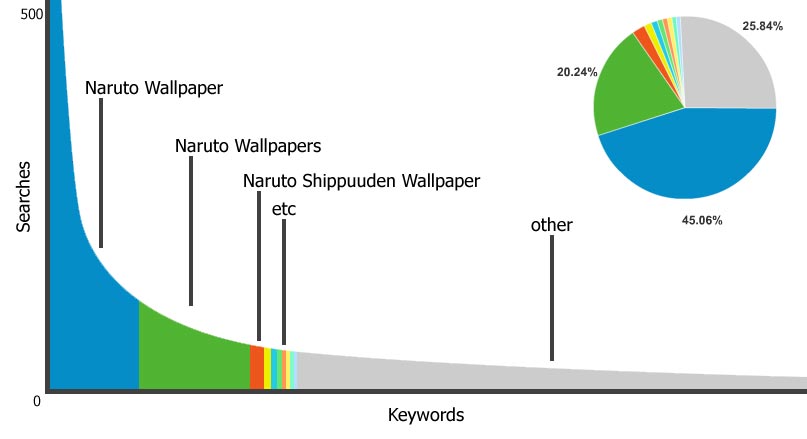
How to Conduct Keyword Research
Keyword research isn’t about finding high volume search terms, link building, and ranking for those search terms. It’s the backbone of a good SEO campaign.
If you do it right, this essential SEO activity can help rank your pages for more search terms and ultimately get you more traffic.
Keywords are like a compass for SEO campaigns because they tell you where to go and whether you’re making progress.
Proper keyword research can help you figure out your thoughts and ideas, and the needs of your target audience. This is because keyword research gives you huge insights into what potential customers are searching for, and the exact words or phrases they use.
According to statistics, 50% of searchers click on the first three search terms they get. And a shocking 75% never reach the second page of Google results. This shows how important high rankings are. But with the ever-changing SERPs and the increasing number of competitors, appearing on Google’s first page is a daunting task.

That’s why you need a solid keyword research strategy to support your SEO efforts.
So, how do you find the right keywords for your SEO strategy? Let’s get started!
- Brainstorm Relevant Topics Based on Your Business
To kick off the keyword research process, think about the topics you want to rank for in generic buckets. Come up with about 5-10 topic buckets that are important to your business and then use those topic buckets to come up with specific keywords later.

These may include topics that come up regularly in sales conversations or the topics you blog about frequently. Put yourself in the shoes of your target audience – what topics would your target customers search for that you want your business to rank for?
If you’re a business selling marketing software, for instance, you may have general topics like:
- Inbound marketing (25K)
- Blogging (20K)
- Email marketing (35K)
- Lead generation (25k)
- Social media marketing (80K)
- Marketing automation (10K)
The numbers in parentheses to the right of each keyword represent their monthly search volume. This information helps you decide how important each topic is to your audience, and how many sub-topics you may need to create content on to be successful with that keyword.
- Fill the Topic Buckets with Keywords
Now, you have a few topic buckets you may want to focus on. Next, identify a few keywords that fall into those buckets. These are keyword phrases you think are important to rank for because your target audience is already searching for those specific search terms.
For instance, if you choose the last topic bucket for a marketing software company – “marketing automation” – you’ll brainstorm a few key phrases that you think people would search for related to that topic. These may include:
- How to use marketing software
- Marketing automation tools
- What’s marketing automation?
- How can you tell if you need marketing automation software?
- Email marketing automation
- Top marketing automation tools
The goal of this step is to come up with the final list of keyword phrases. You want a brain dump of phrases you think potential customers might search for. Also, you can narrow down the list so you don’t end up with something too broad.

After getting your final list, you can use data-driven tools to discover which keywords you’re more likely to rank high for.
- Research Related Search Terms
If you’re having trouble coming up with more keywords, think about how people often refine their search. They might search for a certain topic, go to Google and look at the related search terms that appear as a result. After typing in your phrase, scroll down to the bottom of Google’s results, and you’ll see some suggestions for searches related to your original input. These keywords may spark ideas for other keywords you may want to consider.
That’s a fantastic bonus, right? You’ll come up with more specific keywords that your target audience is searching for.
- Check for a Combination of Long-Tail Keywords and Head Terms in Each Bucket
Do you know the difference between head terms and long-tail keywords? Head terms are keyword phrases that are shorter and more generic; typically, they’re one to three words. In contrast, long-tail keywords are longer keyword phrases that contain three or more words.
It’s essential to make sure that you have a mix of both because it will give you a keyword strategy that’s well-balanced with long-term goals and short-term wins. This is because head terms are searched for frequently, which makes them more competitive and harder to rank for than long-tail keywords.

For example, without looking up search volume or difficulty, which of these two keywords do you think it’ll be harder to rank for?
- How to create high-quality blog posts
- Blogging
If your answer is #2, you’re right. However, don’t get discouraged. Because even though head terms have more search volume, the traffic you’ll get from long-tail keywords is usually more desirable.
Why?
Because people who look for something more specific are much more qualified for your product or service than those looking for something generic. Also, long-tail keywords are more detailed and it’s easy to tell the searcher’s intent.
Therefore, make sure your keyword list has a healthy mix of both head terms and long-tail keywords. You want the quick wins that long-tail keywords offer you, but you should also focus on the more difficult head terms for long-term success.

